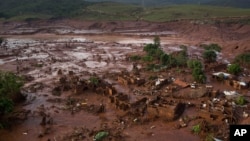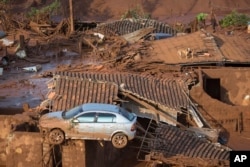Rescue teams searched through mud and debris on Friday for people still missing from a village devastated by the collapse of two dams at a Brazilian mine owned by the world's largest mining company, BHP Billiton.
While only one worker has been confirmed dead, the local governor said the mining disaster caused the most environmental damage of any in the state's history. It could cost the mine's owners a fortune to clean up and repair.
Walls of water filled with mining waste cascaded downhill when the dams burst on Thursday, engulfing the village of Bento Rodrigues and its 600 residents in a sea of mud while also flooding others far removed from the open-pit mine.
Little remains of the village but ruined walls and cars lying twisted in sludge. Search helicopters buzzed overhead as rescuers tried to save a horse trapped in the mud.
"I heard screaming and saw the water coming fast, about 15 to 20 meters high [49-66 feet]," said survivor Antonio Santos, a construction worker who was at home when the dams broke.
Bento Rodrigues is about 93 miles (150 km) southeast of Belo Horizonte, Brazil's third-largest city and the capital of the mining state of Minas Gerais.
"Within 10 minutes the whole lower part of the village was destroyed, about 80 percent of it," he said in a gymnasium crowded with survivors in the nearby city of Mariana.
Santos said he knew of four people who were swept away, including two children and two adults in their 50s.
Mine operator Samarco's chief executive officer said a tremor in the vicinity of the mine may have caused the dams to burst, but that it was too early to establish the exact cause.
The company said one worker died and 13 were missing.
Firefighters initially put the death toll at two but later said they could not immediately confirm more than one fatality connected to the mine disaster.
They said the count could rise because many people were still unaccounted for in six villages hit by floods unleashed by the successive bursting of the two dams holding waste, or iron ore tailings, from the mine.
Samarco is a 50-50 venture between BHP Billiton and Brazil's Vale, the world's largest iron ore miner. The company said it had set no date to restart the mine, which produces about 30 million tons of iron ore annually. Output is shipped to Brazil's coast and converted into pellets for export to steel mills.
The cleanup bill and potential environmental lawsuits could be more costly than the loss of output and come at a bad time for BHP Billiton and Vale, with iron ore prices at their lowest in a decade and one quarter of their 2011 level.
A lawyer specializing in environmental and mining cases said it was too early to estimate the financial setback for the mining companies, since the cause of the disaster was still unknown.
"It impossible to calculate now, but it is not going to be cheap," said Danilo Miranda, of the Marcelo Tostes law firm.
The head of the local miners union, Ronaldo Bento, said it was too early to say whether the company had been negligent.
Shares of Vale closed down 5.7 percent in Sao Paulo trading and BHP Billiton also dropped 5.7 percent in New York.
A Minas Gerais state prosecutor in charge of environmental crimes, Carlos Ferreira Pinto, said he would seek a temporary suspension of Samarco's license on Monday.
Samarco CEO Ricardo Vescovi said the company had been working on the drainage system for the dams. But both had valid licenses from environmental authorities, who last inspected them in July, according to Samarco.
The University of Sao Paulo's seismic center reported four weak tremors in the general area of the mine in the hour before the disaster. But Vescovi said there had been no sign of any breach in the dams immediately after the tremors occurred.
Analysts at Clarksons Platou Securities said the likelihood of a lengthy stoppage at the Samarco mine, which accounts for about one-fifth of seaborne pellet market, could lift iron ore prices.
Prices were not immediately affected, however, and continued to fall on Friday.
Pellet prices have plunged by one-third this year to their lowest in six years amid a global glut and waning Chinese demand.
So-called tailings ponds, masses of finely ground waste rock mixed with water left over from extracting more valuable minerals, can contain harmful chemicals, adding to fears of potential contamination from the Samarco dam bursts.
The company sought to play down those fears, saying there were no chemical elements that posed health risks when the accident occurred.
It was the second major tailings dam disaster in Minas Gerais in 12 years. In 2003, 1.2 billion liters of waste from a tailings dam at a closed cellulose mill broke, flooding local rivers, cutting off fresh water to more than 600,000 people, and killing fish all the way to the Atlantic Ocean.








